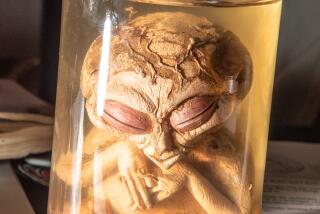Maybe
If one is on a hunt, it is better not to assume at the start that there is no game, or, you won’t get what little there is.
--WILLIAM JAMES [in a 1902 letter]
*
The debate over whether there is intelligent life elsewhere in the universe is an ancient one. Greek and Roman atomists (Leucippus, Democritus, Epicurus, Lucretius) all defended a plurality of worlds. Plato and Aristotle thought otherwise. Medieval Christian thinkers, from Augustine to Aquinas, followed Aristotle and the Bible by confining mortal life to Earth. Pluralism revived during the Renaissance, notably in the writings of the German cardinal Nicholas of Cusa and the Italian ex-monk Giordano Bruno. (It is often said that Bruno was burned at the stake for his belief in many worlds, but it was mainly for other heresies.)
The Copernican revolution, which removed Earth from the center of the cosmos, surely played a role in the intense upwelling of pluralism in post-Renaissance centuries. Kant, Newton, Pope, Voltaire, Paine, Emerson, together with hundreds of writers and scientists, eagerly embraced the notion that intelligent life was everywhere, most likely on Mars, perhaps even on the moon. The leaders of America’s two greatest Adventist movements--Joseph Smith, who started Mormonism, and Ellen White, founder and prophetess of the Seventh-day Adventists-- each defended a plurality of inhabited worlds. White, like the Swedish mystic Emanuel Swedenborg, even had visions of human-like beings on other planets. (Two eminent English exceptions to this belief were the naturalist Alfred Russel Wallace and philosopher of science William Whewell. Each argued strenuously against the possibility of extraterrestrial life.)
A widespread view among today’s scientists is that the universe probably teems with life. There are billions of galaxies, each with billions of stars, and in recent years evidence has been increasing for a plenitude of other solar systems. So far only planets huge enough to cause detectable wobblings of their mother suns have been found, but there is every reason to believe that most suns, perhaps all suns, have planets of all sizes orbiting them.
In recent years, Carl Sagan was the most vocal scientist to trumpet a belief in the plurality of inhabited planets and to urge continual funding of searches for radio messages from extraterrestrial intelligence. Frank Tipler, a physicist at Tulane University, is Sagan’s chief detractor. Tipler thinks the probability of extraterrestrials is zero and that listening for their signals is a big waste of time and money. Less aggressive skeptics include physicist John Wheeler, biologists Ernst Mayr and Jacques Monod, mathematician John Casti, astronomer Martin Rees and a raft of other scientists.
Amir D. Aczel, a statistician at Bentley College in Waltham, Mass., whose previous book, “Fermat’s Last Theorem,” won a 1996 Los Angeles Times Book Prize, is even more certain than Sagan that sentient life is not limited to Earth. In his new book, “Probability 1,” as its title suggests, he maintains that the probability of beings on at least one other planet is so close to 1 as to be indistinguishable from certainty. Although his book covers the same ground as earlier books by others, there are two reasons for recommending it to any person interested in the debate: It is clearly and gracefully written, and it is up to date in its astronomical data.
In 1950, Aczel reminds us, the Italian physicist Enrico Fermi asked a famous question now called Fermi’s paradox. The universe is so vast and so old, Fermi said, that if intelligent life is out there, we can expect many civilizations to have a technology far in advance of our own. Long ago they should have visited Earth. “Where are they?” Fermi asked. Because we have not seen them or heard from them, they probably don’t exist. Like almost all scientists, Fermi dismissed UFO mania as popular superstition.
Many scientists refused to buy Fermi’s argument. There are too many reasons, they said, why extraterrestrials would find it difficult to cover the vast distances between solar systems. Moreover, why would they select Earth from billions of other planets in our galaxy?
Aczel retells the story of how, in the late 1950s, physicist Philip Morrison, astronomer Frank Drake and others concluded that extraterrestrials might be sending messages using a certain frequency of radio waves. Drake’s Project Ozma, named after the Princess of Oz in L. Frank Baum’s popular Oz series, was the first attempt to listen for such messages using a radio telescope at Green Bank, W. Va. Others soon joined in the search. In 1993, a skeptical Congress stopped funding these searches. Drake, Aczel tells us, has continued his work with private funding from corporations. The most efficient search, SERENDIP III, is being conducted by Stuart Bowyer, using the world’s largest radio telescope in Arecibo, Puerto Rico. Since 1992, it has examined 500 trillion signals without detecting a message.
In subsequent chapters, Aczel skillfully covers the recent discoveries of some dozen large planets circling nearby suns, theories about how life arose on Earth and the remote possibility that life could be based on elements other than carbon, as found on Earth. Aczel considers silicon and sulfur, concluding that neither has anywhere near the flexibility of carbon in forming large protein molecules so essential for the specialized tasks they perform in Earth’s life forms. If there is extraterrestrial life, Aczel concludes, it is probably carbon-based. Another chapter deals with “panspermia,” the conjecture that life on Earth began with a seeding of organic material carried here by comets or meteors. This old conjecture has been revived by astronomer Fred Hoyle and biologist Francis Crick.
The famous Mars meteorite discovered in Antarctica in 1996, containing what could be fossil bacteria, is evaluated by Aczel and found to be inconclusive. A chapter is devoted to the influence on Earth’s evolving life by the impacts of large meteors, asteroids and comets. Aczel defends the view that intelligence is not just an accidental product of evolution, as Stephen Jay Gould and others believe, but the inexorable outcome of a tendency for life, once it starts, to evolve creatures with ever superior brains.
The chapter “Does God Play Dice?” introduces the random aspects of quantum mechanics, which Einstein found so distasteful, along with the determinism of chaos theory and Benoit Mandelbrot’s fractals. These topics lead into deep questions about why evolution on Earth produced creatures capable of creating art, music, poetry, mathematics, science and philosophy, none of which seems to have much Darwinian survival value. Are they mere byproducts of a brain designed by nature only to increase efficiency in hunting, fishing, fighting and growing food? Or do they have survival value in some deeper sense not yet understood?
Another chapter concerns what statisticians call the “inspection paradox.” Assume, writes Aczel, that a bus arrives at a bus stop on the average of every 10 minutes. You go there at random moments. One might suppose that the average waiting time would be five minutes, but this is not the case. It’s a trifle longer than five minutes. Why? If the bus arrived at the stop at exactly 10-minute intervals, the average wait would indeed be five minutes. The bus, however, arrives at 10-minute intervals only on the average. If you go to the stop at a random time, the probability is higher that you will arrive at the stop within a long time interval between bus arrivals than during a short interval. Your average wait, therefore, will be longer than five minutes.
To further clarify the paradox, Aczel gives another example. Assume that a flashlight battery has an average life of 3 1/2 hours. Each time you pick up the flashlight you are selecting a random point of time between the random durations between battery use. Like the bus rider, you are more likely to pick up the flashlight between long time intervals than short ones. Result: Your battery will last a trifle longer than its average life.
Aczel applies these examples to Fermi’s question. “If your arrival on Earth is viewed as a random event, you are more likely to land on a longer-lived planet than a shorter-lived one in the same way that a dart is more likely to land on a wider section of the dartboard than on a narrower one.” Our sun is known to have a longer-than-average lifetime. “It is very likely that, as galactic civilizations go, we are on the above-average development level, and possibly way up there among the most advanced. . . . [W]e may be one of the most advanced civilizations anywhere.”
The book’s final chapter is an effort to prove that the probability of life on at least one other planet, though not absolutely certain, is so close to 1 that we can assume certainty. This argument requires a long chain of probability questions that are not, as mathematicians like to say, well-formed. It seems likely there are billions of planets in every galaxy, but astronomers do not yet know how probable it is that a planet meets all the conditions necessary for life. A planet must be neither too hot nor too cold (Aczel calls this the Goldilocks criterion). Does it have water? A suitable atmosphere? How likely is it that carbon is present? Because we do not know the probability that a planet will have all these features, it is impossible, in my opinion, to make a reliable estimate of the chances that conditions on other planets will be conducive to life.
Even if all necessary environmental conditions are present, no one has the slightest notion of how to estimate the probability that carbon molecules, jiggling in a primordial soup, will form self-replicating molecules. It may turn out, as more is learned, that under ideal conditions, it is almost certain that DNA molecules will appear. Or it may turn out, as anti-pluralists insist, that the chance of this happening is so close to zero that it is extremely unlikely that life has arisen anywhere else in our galaxy, perhaps not even in other galaxies.
The view that we are alone in the universe will, of course, be dealt a near-fatal blow if our space probes find some form of life on Saturn’s moon Titan, so rich in atmosphere, or in the seas below the surface ice of Jupiter’s moon Europa. But even if there are low forms of life on Titan or Europa, they will tell us nothing about the probability that given enough time, these life forms will evolve into creatures as intelligent as ourselves. “A sad spectacle!” wrote Thomas Carlyle as he considered the possibility of extraterrestrial life on other planets. “If they be inhabited, what a scope for pain and folly; and if they be not inhabited, what a waste of space!”
I for one would be delighted, albeit a bit terrified, if tomorrow we received a radio signal from outer space that repeated the counting numbers or the prime numbers. As several scientists have warned: “If we hear such a message, don’t answer!” I am equally undismayed by the prospect that Earth is the only planet with life (although we could never be sure of this) and that we are destined to colonize our galaxy. It is said that William Randolph Hearst once cabled a famous British astronomer to request 1,000 words on the question “Is there intelligent life elsewhere in the universe?” Hearst got back an answer in which “Don’t know” was repeated five hundred times.
I, too, have often felt the emotions of that anonymous cowboy who wrote “Home on the Range”:
How often at night,
when the heavens are bright
with the light from the glittering stars,
have I stood there amazed
and asked as I gazed,
does their glory exceed that of ours?






